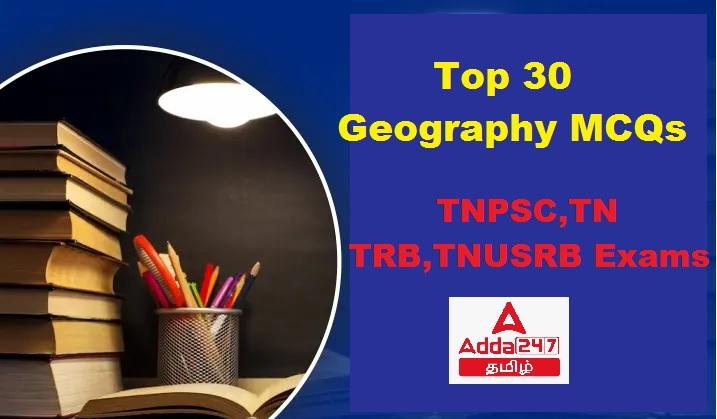பல்வேறு போட்டித் தேர்வுகளில் புவியியல் முக்கியப் பங்காற்றுகிறது, விண்ணப்பதாரர்களுக்கு அவர்களின் தயாரிப்பில் உதவ, நாங்கள் 30 கேள்விகளை (MCQs) தொகுத்துள்ளோம். உங்கள் புவியியல் அறிவை மேம்படுத்துவதற்கும், வரவிருக்கும் தேர்வுகளுக்கு உங்களை சிறப்பாக தயார்படுத்துவதற்கும் ஒவ்வொரு கேள்விக்கும் சரியான பதில் உள்ளது.
Q1.In which year was the first census conducted in India?
(a) 1851
(b) 1872
(c) 1901
(d) 1921
Q2.The lowest layer of earth’s atmosphere is?
(a) Troposphere
(b) Exosphere
(c) Mesosphere
(d) Stratosphere
Q3.Statement 1: India has an official population policy implemented in 1952.
Statement 2: India was the first country to announce such a policy.
(a) Only Statement 1 is correct.
(b) Only Statement 2 is correct.
(c) Both Statement 1 and Statement 2 are correct.
(d) Neither Statement 1 nor Statement 2 is correct.
Q4.What are quinary activities?
(a) Activities related to agriculture and farming
(b) Activities involving manufacturing and production
(c) Activities related to trade and commerce
(d) Activities that focus on the creation, rearrangement, and interpretation of new and existing ideas
Q5.In 1987, which commission cited the definition of sustainability?
(a) Kyoto Commission
(b) Stockholm Commission
(c) Brundtland Commission
(d) Rio Commission
Q6.What are the latitude and longitude coordinates that define the mainland of India?
(a) Latitude: 23o30’N to 26o30’N, Longitude: 77o30’E to 82o30’E
(b) Latitude: 8o4’N to 37o6’N, Longitude: 68o7’E to 97o25’E
(c) Latitude: 40oN to 60oN, Longitude: 10oE to 30oE
(d) Latitude: 0oN to 10oS, Longitude: 90oE to 120oE
Q7.Which type of polar projection is depicted on the United Nations flag?
(a) Mercator projection
(b) Robinson projection
(c) Azimuthal polar projection
(d) Conic projection
Q8.What does the acronym GNSS stand for?
(a) Global Network of Satellite Systems
(b) Global Navigation and Satellite System
(c) Global Navigation Satellite System
(d) Global Network for Space Surveillance
Q9.Which of the following pairs is incorrect in terms of satellite navigation systems?
(a) Europe – Galileo
(b) USA – NAVSTAR Global Positioning System (GPS)
(c) Russia – Globalnaya Navigation Naya Sputnikovaya Sistema (GLONASS)
(d) China – Global Navigation Satellite System (GNSS)
Q10.Which country has the densest seismic network in the world?
(a) China
(b) United States
(c) Japan
(d) Australia
Q11.Which of the following is NOT an erosional landform created by sea waves?
(a) Sea cliff
(b) Sea cave
(c) Arch
(d) Beach
Q12.What term is used to describe isolated residual hills that rise abruptly from their surroundings?
(a) Inselbergs
(b) Buttes
(c) Plateaus
(d) Mesas
Q13.Glacial debris gets deposited in low-lying areas and forms various depositional features. Which of the following options correctly identifies some of these depositional features?
(a) Moraines, valleys, plateaus, deltas
(b) Drumlins, canyons, ridges, floodplains
(c) Eskers, mesas, dunes, alluvial fans
(d) Moraines, drumlins, eskers, kam
Q14.What is another name for a composite volcano?
(a) Cinder cone volcano
(b) Shield volcano
(c) Caldera volcano
(d) Stratovolcano
Q15.When did the Indian Ocean tsunami occur?
(a) Dec 26 2003
(b) Dec 26 2004
(c) Dec 26 2005
(d) Dec 26 2006
Q16.Which landmass was the Indian Plate a part of, along with modern Africa, Australia, Antarctica, and South America?
(a) Laurasia
(b) Pangea
(c) Gondwana
(d) Eurasia
Q17. Match the following
Volcanoes – country
- Mt. Fujiyama – USA
- St. Helens – Japan
- Mt. Kilimanjaro – Mexico
- Parícutin – Tanzania
(a) a-4, b-3, c-2, d-1
(b) a-1, b-2, c-3, d-4
(c) a-2, b-1, c-4, d-3
(d) a-4, b-1, c-2, d-3
Q18. Match the following
- Indian ocean – Willy willy
- Atlantic ocean – Typhoons
- Western pacific ocean – Hurricanes
- Australia – Cyclones
(a) a-4, b-3, c-2, d-1
(b) a-1, b-2, c-3, d-4
(c) a-2, b-1, c-4, d-3
(d) a-4, b-1, c-2, d-3
Q19. Match the following
Local wind – Region
- Foehn – Thar desert, India
- Chinook – Alps – Europe
- Mistral – Mediterranean sea – France
- Loo – Rockies – North America
(a) a-4, b-3, c-2, d-1
(b) a-1, b-2, c-3, d-4
(c) a-2, b-4, c-3, d-1
(d) a-2, b-4, c-1, d-3
Q20. Which of the following are not erosional landforms of River?
(a) Gorges and Canyons
(b) Meander
(c) Ox bow lake
(d) Alluvial fan
Q21. World soil day is observed on _____.
- a) 15th August
- b) 12th January
- c) 15th October
- d) 5th December
Q22. Which one of the following is the most productive category of soil?
- a) Alluvial soil
- b) Black soil
- c) Red soil
- d) Mountain soil
Q23. Earth’s atmosphere contains about ________ percentage of carbon dioxide.
- a) 0.3%
- b) 0.03%
- c) 0.003%
- d) 3%
Q24. _________ is used to measure the wind speed.
- a) Anemometer
- b) Barometer
- c) Hygrometer
- d) Thermometer
Q25. The Bureau of Indian Standards has grouped our country into _______ seismic zones.
- a) 3
- b) 4
- c) 5
- d) 6
Q26. The headquarters of the National Institute of Disaster Management is located at _______.
- a) New Delhi
- b) Hyderabad
- c) Mumbai
- d) Chennai
Q27. In India _______ is known as ‘Detroit of India’.
- a) New Delhi
- b) Hyderabad
- c) Mumbai
- d) Chennai
Q28. Cement Industries are the examples of ________ industries.
- a) Agro based
- b) Mineral based
- c) Forest based
- d) Marine based
Q29. The rain drops with _______ mm in diameter is known as rain.
- a) <0.005
- b) <0.05
- c) <0.5
- d) <5
Q30. The transmission of heat energy from one body to the other body without any medium is called ________.
- a) Conduction
- b) Convection
- c) Radiation
- d) Ionization
SOLUTION
S1. Ans. (b)
Sol.
The first census was carried out in the year 1872.
S2. Ans. (a)
Sol.
S3. Ans. (c)
Sol.
India has an official population policy implemented in 1952. India was the first country to announce such a policy.
S4. Ans. (d)
Sol.
Quinary activities that focus on the creation, rearrangement, and interpretation of new and existing ideas
S5. Ans. (c)
Sol.
In 1987, the Brundtland Commission cited the definition of sustainability. “Sustainable development is development that meets the needs of the present without compromising the ability of future generations to meet their own needs”.
S6. Ans. (b)
Sol.
The mainland of India extends from 8o4’N to 37o6’N latitude and from 68o7′ E to 97o25′ E longitude.
S7. Ans. (c)
Sol.
The “azimuthal” polar projection is depicted on the United Nations flag.
S8. Ans. (c)
Sol.
Global Navigation Satellite System (GNSS) is a satellite system connected with a small electronic receiver or tracker to locate, monitor and track a user’s vehicle wherever in the world.
S9. Ans. (d)
Sol.
Europe-Galileo
USA-NAVSTAR Global Positioning System (GPS)
Russia- Globalnaya Navigation Naya Sputnikovaya Sistema (GLONASS)
China- BeiDou Navigation Satellite System
India’s-IRNSS (NAVIC) system
S10. Ans. (c)
Sol.
Japan is in a very active seismic area and it has the densest seismic network in the world
S11. Ans. (d)
Sol.
Some of the erosional landforms of sea waves are sea cliff, sea cave, arch, stack, beach, bar and spit and wave cut platform
S12. Ans. (a)
Sol.
Inselberg is a German term which means an island mountain. Such isolated residual hills rising abruptly from their surroundings are termed as inselbergs.
S13. Ans. (d)
Sol.
Glacial debris gets deposited in the low lying areas and forms depositional features like moraines, drumlins, eskers, kames and outwash plains.
S14. Ans. (d)
Sol.
Composite volcano, also known as stratovolcano is a conical volcano built by many layers of hardened lava, pumice and volcanic ash. ex, Fijiyama.
S15. Ans. (b)
Sol.
On 26 December 2004 a tsunami occurred in the Indian Ocean. It was the result of the Indo-Australian Plate subducting below the Eurasian Plate. It was caused by an Earthquake measuring a magnitude of above 9 in the Richter scale.
S16. Ans. (c)
Sol.
About 250 million years ago, the Indian Plate was a part of the Gondwana land, which comprised modern Africa, Australia, Antarctica, and South America.
S17. Ans (c) a-2, b-1, c-4, d-3
Sol.
Mt. Fujiyama – Japan
St. Helens – USA
Mt. Kilimanjaro – Tanzania
Parícutin – Mexico
S18. Ans (a) a-4, b-3, c-2, d-1
Sol.
Indian ocean – Cyclones
Atlantic ocean – Hurricanes
Western pacific ocean – Typhoons
Australia – Willy willy
S19. Ans (c) a-2, b-4, c-3, d-1
Sol.
Foehn – Alps – Europe
Chinook – Rockies – North America
Mistral – Mediterranean sea – France
Loo -Thar desert, India
S20. Ans (d) Alluvial fan
Sol.
Erosional landforms of rivers – Gorges and Canyons, Meander, Ox bow lake, V-shaped valley.
Alluvial fans are depositional landforms of the river.
S21. Ans (d)
Sol.
- World Soil Day is observed on 5th December, every year.
S22. Ans (a)
Sol.
- Alluvial soils are formed by the deposition of silt by the running water.
- It is the most productive of all soils.
- It is suitable for the cultivation of sugarcane, jute, rice, wheat and other food crops.
S23. Ans (b)
Sol.
- Earth’s atmosphere is a layer of gases surrounding the planet earth and retained by the earth’s gravity.
- It contains about 78% Nitrogen, 21% Oxygen, 0.97% Argon, 0.03% Carbon Dioxide and 0.04% trace amounts of other gases and water vapour.
S24. Ans (a)
Sol.
- Rainfall – Rain gauge
- Atmospheric pressure – Barometer
- Wind speed – Anemometer
- Wind direction – Wind wane
- Humidity – Hygrometer
S25. Ans (b)
Sol.
- Based on the scientific inputs relating to seismicity, earthquakes occurred in the past and tectonic setup of the region, Bureau of Indian Standards has grouped the country into four seismic zones: Zone II, Zone III, Zone IV and Zone V (No area of India is classified as Zone I).
S26. Ans (a)
Sol.
- National Institute of Disaster Management is located at New Delhi.
S27. Ans (d)
Sol.
- In India Chennai is known as ‘Detroit of India’.
- It has the world famous automobile industries such as GM, Ford, Hyundai and Mahindra.
- The city accounts for 60% of the country’s automotive exports.
S28. Ans (b)
Sol.
- Mineral Based Industries are the industries that use mineral ores as their raw materials.
- Iron made from iron ore, cement, machine tools, etc. are the examples of mineral based industries.
S29. Ans (c)
Sol.
- The precipitation in which the size of rain drops are <0.5 mm in diameter is known as drizzle and the rain drops with >0.5 mm in diameter is known as rain.
- Generally drizzle takes place from stratus clouds.
S30. Ans (c)
Sol.
- Radiation is the transmission of heat energy from one body to the other body without any medium.
**************************************************************************
 இது போன்ற தேர்விற்கான தகவல் மற்றும் பாடக்குறிப்புகளை பெற ADDA247 தமிழ் செயலியை பதிவிறக்கம் செய்யுங்கள்
இது போன்ற தேர்விற்கான தகவல் மற்றும் பாடக்குறிப்புகளை பெற ADDA247 தமிழ் செயலியை பதிவிறக்கம் செய்யுங்கள்| Adda247 TamilNadu Home page | Click here |
| Official Website=Adda247 | Click here |



